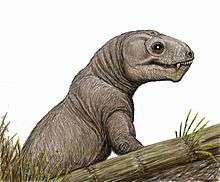Biseridens
| Biseridens Temporal range: Middle Permian, 270 Ma | |
|---|---|
 | |
| Scientific classification | |
| Kingdom: | Animalia |
| Phylum: | Chordata |
| Order: | Therapsida |
| Clade: | Neotherapsida |
| Suborder: | †Anomodontia |
| Genus: | †Biseridens Li and Cheng, 1997 |
| Species | |
| |
Biseridens is the most basal genus of anomodont therapsid.[1] A well-preserved skull found from the Xidagou Formation, outcropping in the Qilian Mountains of Gansu, China
Classification
Synapomorphies distinguish Biseridens as an anomodont and not an eotitanosuchian as previously described: short snout; dorsally elevated zygomatic arch and septomaxilla lacking elongated posterodorsal process between nasal and maxilla. The presence of a differentiated tooth row; denticles on vomer, palatine and pterygoid; contact between tabular and opisthotic; lateral process of transverse flange of pterygoid free of posterior ramus and absence of mandibular foramen exclude it from other anomodonts. Cladistic analysis indicates Biseridens to be the most basal anomodont, highlights separate Laurasian and Gondwanan basal anomodont clades and suggests that dicynodonts had their origins in the Gondwanan clade.[1]
See also
References
- 1 2 Liu, J.; Rubidge, B.; Li, J. (2009). "A new specimen of Biseridens qilianicus indicates its phylogenetic position as the most basal anomodont". Proceedings of the Royal Society B. 277 (1679): 285–292. doi:10.1098/rspb.2009.0883. PMC 2842672
 . PMID 19640887.
. PMID 19640887.